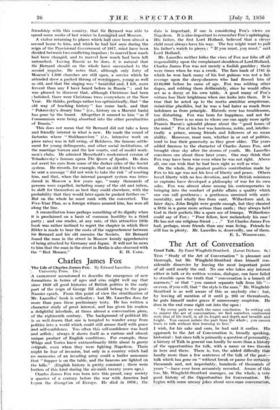The Art of Conversation Good Talk. By Esme Wingfield-Stratford. (Lovat
Dickson. 6s.) Tuts " Study of the Art of Conversation " is pleasant and thorough, but Mr. Wingfield-Stratford does himself con- siderable disservice by leaving the most important point of all until nearly the end. No one who takes any interest
either in talk or its written version, dialogue, can have failed to stumble upon the truth that " conversation is a branch of manners," or that " you cannot separate talk from life
or even, if you will, that " the style is the man." Mr. Wingfield- Stratford is as well aware of this as anybody else : but, by leaving all mention of it until p. 203 or thereabouts, he puts himself 'under grave if unnecessary suspicion. He does in the end come right out into the open : " By every path we reach the same conclusion. In setting out to master the art of .conversation, we find 'ourselves confronted with that of life itself, in all its length and depth and breadth and height. You cannot isolate the part from the whole ; you cannot learn to talk without first learning to live."
I wish, for his sake and ours, he had said it earlier. His approach to the Art of Conversation is, broadly speaking, historical : but since talk is primarily a question of personalit a history of Talk in general can hardly be more than:a hist . of the opportunities for talk, with a name or two thro*r
in here and there. 'There is, too, the added difficulty that hardly more than a few sentences, of the talk Of the past— talk which has gone on " without break or pause for certainly thousands and, not improbably, hundreds of thousands of years "—have ever been accurately recorded. Aware of this too, Mr. Wingfield-Stratford manages, on the whole, a very good histay cif'. the - Oliportunities for Conversation. He begins with some uneasy jokes about cave-man conversation, but is soon in full swing with a delightful- account of the Golden Age of Athens, in the course of which he. says of the Socratic method :
" It is no small tribute to the charin and courtesy that seem to have impressed everybody who came* into contact with Socrates, that he should have attained to a ripe old age before anybody thought of silencing him with the hemlock."
From Greece he comes in time to the Renaissance, and so to the eighteenth-century salons, the nineteenth-century anti- cliniax, and the present day. Dr. Johnson of course gets his due, and so does the talk at Urbino which produced that little masterpiece, Castiglione's Courtier : and for his final tribute he makes a most impressive return to the sayings of Christ in the Gospels. When at last he has decided on the
essentials of conversation, Mr. Wingfield-Stratford goes briskly and convincingly forward ; his earlier remarks, not
unnaturally; sometimes lack direction—as, for instance, his condemnation of the cliche. And it is significant that he says on one page " The art of conversation spread Northward
with the Renaissance," and yet, immediately, has to leap back two centuries from Elizabethan times and pay tribute to those " artists of conversation " the Canterbury Pilgrims.
Right values, good manners, and a gift for the truly creative remark—the unpredictable : these are the essentials of good conversation as he sees them; and it would be hard to suggest better ones. But, once civilisation has reached a certain point, these are as likely to be found among the Canterbury Pilgrims as among the Blue-Stockings, and no less likely in our own degenerate age than they were in the days of Socrates. Mr. Wingfield-Stratford's book is not written in a conversational style, but it has at any rate one good conversational quality : it is stimulating enough to make one















































 Previous page
Previous page